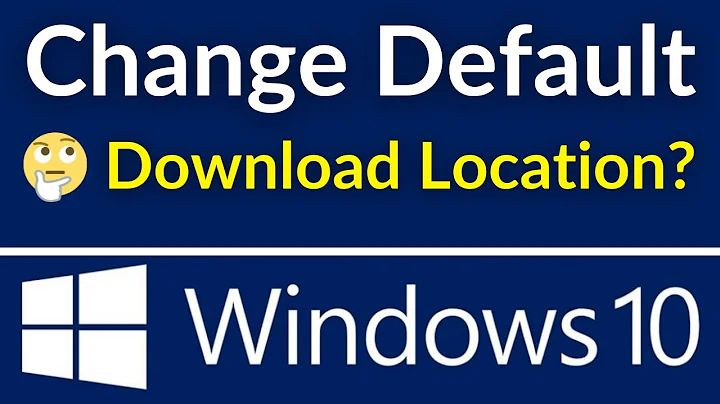How can I change Windows' default download path?
Solution 1
The easiest solution is to make C:\Downloads a link to C:\Users\Myname\Downloads: then either path can be used to access the down-loads.
In order to create any file in the root directory you need to start a Command Prompt with administrator privileges (it's an option when you right-click the Windows Start button on the task-bar). Then issue the command:
mklink /d C:\Downloads C:\Users\Myname\Downloads
There is no need to change anything else, nor to move existing files, which are retained in the user directory hierarchy along with new files subsequently added, so they will be included whenever the user directory is backed up.
You can use a similar technique to create C:\Documents, C:\Music, C:\Pictures, etc.
Solution 2
- Open Explorer.
- Create the folder you want to have as your new Downloads folder (i.e.:
c:\downloads). - Under "This PC", right-click "Downloads".
- Click Properties.
- Select the Location tab.
- Click Move.
- Select the folder you made in step 2.
- Once it's done copying things hit OK to close the properties window.
Solution 3
It's not Windows itself that downloads files, but rather, it's applications like browsers or other network clients. If you're talking specifically about downloading files from the world wide web, your browser has a setting for the default download location. You can even set it to ask you each time where you want to put a file that you're about to download.
Solution 4
Properly designed Windows applications use the IKnownFolderManager or just SHELL32.DLL's function SHGetKnownFolderPath (or its compatibility wrapper, SHGetFolderPath ) to find the paths to locations like your Downloads folder. The KNOWNFOLDERID for the Downloads folder is FOLDERID_Downloads, which has GUID {374DE290-123F-4565-9164-39C4925E467B}.
If you open the Registry Editor and search for keys and values with that GUID, you'll eventually find it in the following two places:
HKEY_CURRENT_USER\SOFTWARE\Microsoft\Windows\CurrentVersion\Explorer\Shell Folders
HKEY_CURRENT_USER\SOFTWARE\Microsoft\Windows\CurrentVersion\Explorer\User Shell Folders
As explained in the blog linked by Ben N, ...\Shell Folders only exists for compatibility with some Windows 95 programs. It even contains a value with the name !Do not use this registry key and data Use the SHGetFolderPath or SHGetKnownFolderPath function instead. These functions look at the key ...\User Shell Folders instead.
Programs like Microsoft Edge and Google Chrome will use the path reported by the IKnownFolderManager to store downloads by default, though Google Chrome allows you to provide an override for this path (in the "Advanced settings" portion of its settings screen). If the path doesn't point to an existing folder, Microsoft Edge will simply complain, and Google Chrome will default to the "Downloads" folder in your Document folder.
I have noticed that Techie007's answer crashes for me (Windows 10 is such a quality product), but not before copying all my downloads and adding a new value to the keys above with the GUID {7D83EE9B-2244-4E70-B1F5-5393042AF1E4}. I can't find any reference to that GUID on MSDN. Microsoft Edge doesn't seem to care about that value, and nor does Google Chrome.
So if Techie007's answer doesn't work for you, maybe you could void your warranty and try to change the value in the registry:
Windows Registry Editor Version 5.00
[HKEY_CURRENT_USER\SOFTWARE\Microsoft\Windows\CurrentVersion\Explorer\User Shell Folders]
"{374DE290-123F-4565-9164-39C4925E467B}"="C:\\Downloads"
Solution 5
The simplest way I found is to move the entire folder to the new location. Do it as follows:
- Open C:\ in explorer
- Open C:\Users\Username in another explorer
- Right click and drag the Download folder to C:\
- Release the right mouse button
- Select
Move here - Windows detects the change and sets things up for you
This way you don't have to do any linking, registry editing or changing libary settings, windows takes care of it.
As far as I tried it works with every so called 'library' (Documents, Music, Downloads, etc.) in your user folder, you can even move them to network drives.
However you may need to click on the 'Download' shortcut in the little save dialog next time you download something as either the windows explorer or sometimes the application itself tends to remember the old save location, or pre-select the Desktop folder when the original folder doesn't exists anymore. After doing this once things should continue as before.
Related videos on Youtube
Dr. John A Zoidberg
Updated on September 18, 2022Comments
-
 Dr. John A Zoidberg over 1 year
Dr. John A Zoidberg over 1 yearI'd like to keep my drive paths as clean as possible, and
C:\Downloadsis much nicer thanC:\Users\Myname\Downloads. Can I stop Windows 10 from doing this by default?-
Ramhound over 7 yearsYou can create a folder in that location, and tell your browser to download files to that location, but that location would require the process to run at an elevated permission in order to do that.
-
 Dr. John A Zoidberg over 7 yearsYes, but it's rather bothersome to have to specify the path every time. Is there no way to set it to default? I'm the only user on my PC so using the users folder seems pointless.
Dr. John A Zoidberg over 7 yearsYes, but it's rather bothersome to have to specify the path every time. Is there no way to set it to default? I'm the only user on my PC so using the users folder seems pointless. -
 AFH over 7 yearsYou can make
AFH over 7 yearsYou can makeC:\Downloadsa link toC:\Users\Myname\Downloads, and then access it as if that's where the down-loads had gone. -
 Dr. John A Zoidberg over 7 years@afh How does one do that?
Dr. John A Zoidberg over 7 years@afh How does one do that? -
 AFH over 7 yearsUse
AFH over 7 yearsUsemklink /d C:\Downloads C:\Users\Myname\Downloads. You will need a Command Prompt with administrator privileges to set up the link, but not thereafter. -
zzzzBov over 7 yearsThere's no such thing as a "clean" path.
%userprofile%\Downloadsis better for organization thanC:\downloadsonce you consider a multi-user environment. -
user253751 over 7 years@zzzzBov Most desktops are not multi-user environments.
-
Ian M over 7 years@AFH not sure your link solution will work as windows protects user folders like that. The correct solution is below.
-
 Guntram Blohm over 7 yearsNote that when you want to make a backup, or move to a new computer, having everything below C:\users\Myname makes things a lot easier than several directories distributed all over the file system.
Guntram Blohm over 7 yearsNote that when you want to make a backup, or move to a new computer, having everything below C:\users\Myname makes things a lot easier than several directories distributed all over the file system. -
 AFH over 7 years@IanM - The down-loads still go into
AFH over 7 years@IanM - The down-loads still go intoC:\Users\Myname\Downloads, as at present, but they can they be accessed throughC:\Downloads. -
 AFH over 7 years@GuntramBlohm - My suggestion means that the down-loads will still be backed up along with the user's folder.
AFH over 7 years@GuntramBlohm - My suggestion means that the down-loads will still be backed up along with the user's folder. -
 phuclv over 7 yearsthere's no major single user OS nowadays. The use of user folder is a must
phuclv over 7 yearsthere's no major single user OS nowadays. The use of user folder is a must -
gronostaj over 7 yearsDumping user profile folders into system drive's root is hardly "as clean as possible". Frankly, these shouldn't be on that drive at all - that would make OS drive immune to being filled with your files and would make reinstalling OS safer.
-
Jack Aidley over 7 yearsYou're better off stopping fighting the OS and following it's design.
-
 Jason C over 7 yearsIt's funny. I was like you, once. (lol) In the distant past I used to try to keep everything in a little "Data" folder or whatever outside of my user directory, then eventually after shooting myself in the foot so many times I realized just how much more organized it was to keep everything in my user folder like I was supposed to. So much easier for backups, migrating to new computers, the unforeseen cases where I did end up making new accounts (e.g. letting a friend borrow a laptop, making a user account for work, etc.). Even easier if you keep all the user data on a separate partition.
Jason C over 7 yearsIt's funny. I was like you, once. (lol) In the distant past I used to try to keep everything in a little "Data" folder or whatever outside of my user directory, then eventually after shooting myself in the foot so many times I realized just how much more organized it was to keep everything in my user folder like I was supposed to. So much easier for backups, migrating to new computers, the unforeseen cases where I did end up making new accounts (e.g. letting a friend borrow a laptop, making a user account for work, etc.). Even easier if you keep all the user data on a separate partition. -
 Jason C over 7 years(The only thing I really use a root folder for now is I have a "\Programs" folder that I put manually-installed software in, for applications that don't have installers available.)
Jason C over 7 years(The only thing I really use a root folder for now is I have a "\Programs" folder that I put manually-installed software in, for applications that don't have installers available.)
-
-
rackandboneman over 7 yearsYES, but these applications are preferred to use an OS-wide setting, as Rhymoid describes below.
-
Sanctor over 7 yearsSome programs do not obey this setting. They are hardcoded to use the downloads folder under the user folder. In that case, the downloads shortcut won't show the one under the user folder and you'll have to navigate to it yourself. One such program is Media Player Classic when taking screenshots.
-
 Ben N over 7 yearsRelevant Old New Thing article about the Shell Folders key.
Ben N over 7 yearsRelevant Old New Thing article about the Shell Folders key. -
joojaa over 7 yearsGoing further it might be a goid idea to make a new virtual drive called z or v or something.
-
 Captain Man over 7 yearsThis won't make future downloads go in the new location though.
Captain Man over 7 yearsThis won't make future downloads go in the new location though. -
 AFH over 7 years@joojaa - That's a good alternative: you could use
AFH over 7 years@joojaa - That's a good alternative: you could usesubst h: %homepath%(or some other drive letter), but it would need to be done on each log-in. You can then refer toH:\Downloadsetc, and the single command maps the whole home directory. -
 AFH over 7 years@joojaa - See also this question.
AFH over 7 years@joojaa - See also this question. -
joojaa over 7 yearsYes net use can make it permanent and you can do it trough a GUI if you so wish. You can also make logical disks with disk manager so you can combine two separate disks into one if you want.
-
 AFH over 7 years@joojaa - Thanks, I didn't know about
AFH over 7 years@joojaa - Thanks, I didn't know aboutnet use h: /home, although it gives an error on W10/1607. -
Charles Burge over 7 yearsWell, I think that's a matter of opinion and I respectfully disagree. Maybe some people don't want their browser saving files to the same location as their bit torrent client or their email client. Personally, I like having my browser ask me where to put a file, because I might want to put it in a different place depending on whether it's an mp3 file or an iso image or something else.
-
MiniRagnarok over 7 years@Sanctor As near as I can tell Media Player Classic uses the last location you saved in. It's not hard-coded. trac.mpc-hc.org/ticket/1390
-
 Kimmax over 7 yearsI pretty sure it does because windows adjusts the library paths too. Actually I will test this right now
Kimmax over 7 yearsI pretty sure it does because windows adjusts the library paths too. Actually I will test this right now -
 Kimmax over 7 yearsIt works, as long as you don't mind clicking the download shortcut in the save dialog once on the first download, as e.g. chrome remembers the old location. Second download goes right into the moved folder
Kimmax over 7 yearsIt works, as long as you don't mind clicking the download shortcut in the save dialog once on the first download, as e.g. chrome remembers the old location. Second download goes right into the moved folder -
 Captain Man over 7 yearsYour answer should probably mention something about that then since that's the actual part OP cares about; I'm sure they understand they can manually move things there.
Captain Man over 7 yearsYour answer should probably mention something about that then since that's the actual part OP cares about; I'm sure they understand they can manually move things there. -
Gilsham over 7 yearsThis should also junction the new downloads folder into your user folder so hard coded programs should get the right place as well
-
Amani Kilumanga over 7 years@MiniRagnarok it is hard coded to the last location you saved in.
-
rackandboneman over 7 yearsIf it is advertised as best practice by an OS vendor, it is the opinion of the vendor and of developers that matters :) And I guess very few people would prefer the DEFAULT to be arbitrary rather than taken from a system wide setting. There are good reasons for users and admins to modify that default, for example if you are using roaming profiles or central backup in an organization and do not want an in-profile/in-backup folder to get cluttered with trivial, bulky downloads. Application-level override is of course a desirable feature in most cases.




![Change Default Install Location Windows 10 [Tutorial]](https://i.ytimg.com/vi/KEAFPj7rPTU/hqdefault.jpg?sqp=-oaymwEcCOADEI4CSFXyq4qpAw4IARUAAIhCGAFwAcABBg==&rs=AOn4CLB-tg5Qukql_lfVFVZTBEZQJapl2A)
